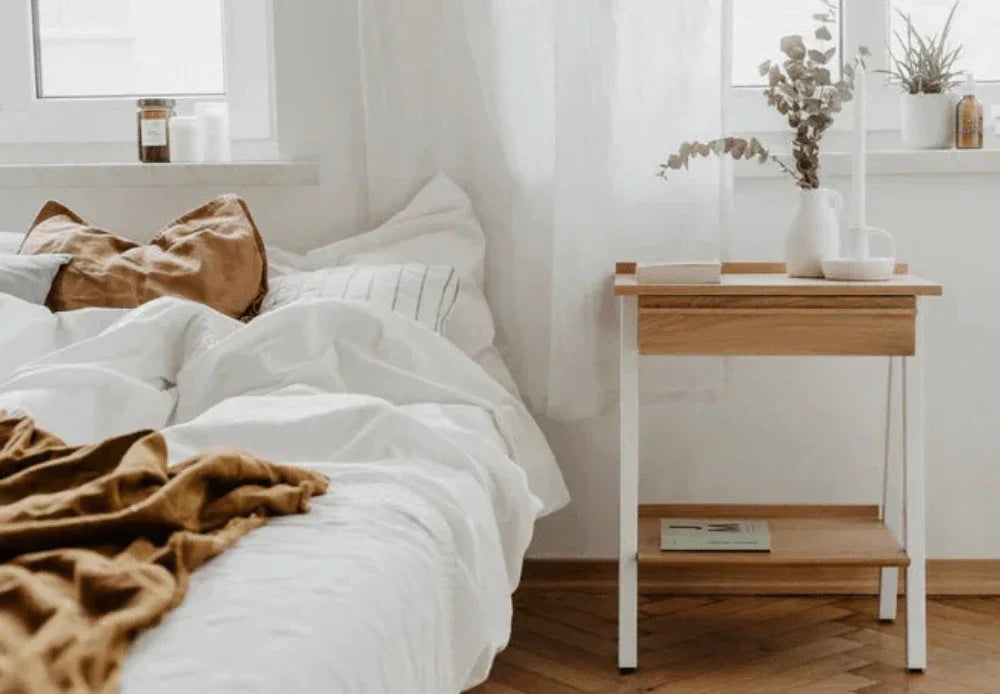Wood — a material that has fascinated for centuries with its naturalness, warmth, and timeless beauty. It brings not only elegance but also a bit of nature to interiors, hidden in the grain patterns, roughness of the surface, and the scent that evokes a forest after rain. However, for wooden furniture to captivate for years, it requires our care. Wooden furniture requires maintenance — delicate, regular, and conscious.
This is not only a matter of aesthetics but also a way to keep wooden furniture in excellent condition. Proper maintenance of wooden furniture allows it to withstand the test of time, preserving its charm and functionality. Natural maintenance of furniture thus becomes not only a practice but also a form of respect for craftsmanship, tradition, and the material from which it was made.
In this guide, we will introduce you to the world of conscious care for wood — from daily cleaning to advanced care treatments for wooden furniture, helping you enjoy their durability and beauty for many years.
Table of contents:
- What to clean wooden furniture with? Cleaning products for wood
- How to clean wooden surfaces?
- Wooden furniture maintenance
- Wooden furniture care. Common mistakes and recommendations
What to clean wooden furniture with? Cleaning products for wood
Wood, although durable, cannot tolerate mediocrity. To keep it pleasing to the eye for decades, it needs rituals that not only clean but also restore its inner peace. Cleaning wooden surfaces is more than an obligation — it’s a gesture of care that should become part of our daily habits. The right method makes cleaning wooden surfaces not just a technical task, but a form of subtle dialogue with the material.
To clean wood properly means understanding its needs. We treat delicate, oiled textures differently than wood exposed to rain and sun. In this chapter, we’ll introduce you to various techniques — from home remedies, through ecological alternatives, to cleaning with specialist products that bring even the most tired surfaces back to life.
wooden coffee table for the living room
Homemade wood cleaning methods
Not everything that is effective has to be chemical. There are homemade ways of cleaning wood that have been passed down from generation to generation — simple, effective, and completely natural. If you're interested in how to clean wooden furniture safely and ecologically, we recommend our separate guide:
👉 How to clean wooden furniture – homemade methods There, you’ll find information on using vinegar, olive oil, lemon, or baking soda — ingredients you already have in your kitchen, which you can successfully use to care for wood.
Soda blasting as an ecological alternative
When wood needs thorough cleaning and we want to preserve its structure and character, it's worth considering soda blasting. This method is perfect for cleaning wooden outdoor furniture, which is exposed to the elements.
Soda blasting is a cleaning method that uses compressed air and fine-grained baking soda. This technique is similar to sandblasting, but much gentler — it does not affect the wood’s structure or strip surface layers. It is usually performed with specialized equipment (a soda blaster), so it is recommended as a professional service, although there are home kits available that can be used with a compressor.
Thanks to this method, you can achieve spectacular cleaning results without using aggressive chemicals. Moreover, soda blasting is an entirely eco-friendly process — it respects not only the furniture but also the environment.
Cleaning with specialist products
Some stains are exceptionally difficult to remove with home methods. In such situations, it's worth using a specialist cleaning product that is suited to the type of wood and the finish of the surface. Below is an overview of available forms and their applications:
Liquid or concentrate plant-based soaps
- Delicate, natural products mainly for oiled, waxed, or raw furniture.
- Used with water or as a ready-made solution — for wiping surfaces.
- Great for daily refreshing of furniture, without the risk of damage.
Cleaning creams and regenerative emulsions
- Thicker consistency products, used on tough stains, discoloration, and worn-out surfaces.
- They often contain natural oils or waxes, which also nourish the wood.
- Perfect for furniture that needs refreshing or light renovation.
Neutral pH sprays
- Ready-to-use spray products — convenient to apply, no dilution required.
- Intended for lacquered or painted surfaces, which can be sensitive to acidic or alkaline products.
- They provide quick cleaning without streaks and without the risk of damaging the protective coating.
Products with UV filters or hydrophobic properties
- Primarily used for outdoor furniture and terraces — wood exposed to sunlight, moisture, and organic dirt.
- They protect the surface from fading, cracking, and water absorption.
- Recommended for seasonal use or before the start of the summer season.
Scandinavian wooden desk Fjord
How to clean wooden surfaces?
Cleaning wooden outdoor furniture
Cleaning wooden furniture is an essential maintenance task, especially for **wooden outdoor furniture**, which is exposed to weather conditions such as rain, sun, dust, and moisture. To maintain their durability and natural appearance, you need to adjust the cleaning method to the type of wood finish.
Lacquered and impregnated furniture: simply wipe them with a damp cloth and a mild wood cleaner, preferably with a neutral pH that will not damage the protective coating.
Oiled furniture: these surfaces are more absorbent, so they require a gentler approach. Use specialized products for cleaning oiled wood, which do not dry out the material or dull the surface. Natural oil or plant-based soap products are a good choice, which you can apply using a soft microfiber cloth. After cleaning, apply a layer of protective oil to safeguard the wood from harmful weather conditions.
More difficult stains (e.g., grease, algae, rain residue): In such cases, it’s worth using stronger products designed for outdoor wood. These are often cleaning creams or concentrates that effectively remove stains without affecting the wood's structure. Such products are available in versions suited to various finishes — oiled, lacquered, or waxed. It's worth choosing products intended for outdoor furniture, which often also contain ingredients that protect the wood from UV rays and moisture.
Cleaning wooden outdoor furniture should be done every few weeks during the season, as well as before and after the summer season, to ensure proper protection for longer.
Cleaning wooden floors
Floors are the most heavily used wooden surfaces in the home. Every day, they are exposed to abrasion, dirt, and varying humidity conditions. Cleaning wooden floors should therefore not only be effective but also safe — so as not to cause cracking, dullness, or discoloration.
The best method is gentle but regular cleaning, using a well-wrung microfiber cloth and special cleaners intended for wooden floors. Avoid excess water — wood does not tolerate it.
Cleaning baseboards
Although often overlooked in daily cleaning, baseboards also require attention. Cleaning wooden surfaces along walls helps maintain the aesthetics of the entire interior and prevents dust and moisture buildup.
In this case, thorough yet gentle cleaning of the wood works best — ideally with a slightly damp cloth and a natural wood cleaner or a bit of Castile soap.
Desk that grows with the child
Wooden furniture maintenance
Once the wood has been cleaned of everyday dust, stains, and residue, it's time to take deeper care of its condition. Maintenance treatments for wooden furniture determine whether the furniture will retain its structure, color, and shine for many more years.
Wooden furniture requires maintenance not only during crises — scratches, dullness, dryness — but also preventively. Only then does the wood remain flexible, saturated, and resistant to external factors. Moreover, natural furniture care does not necessarily mean complicated and time-consuming procedures. Sometimes a moment and the right product are enough to restore the wood's shine.
Oils and waxes for wood – protection and polishing
Oiling and waxing is like giving wood a second skin. These natural products create a delicate but effective protective layer that guards against drying, staining, and moisture.
Using plant oils (such as linseed or tung oil) strengthens the color, enhances the grain, and introduces a warm depth. Wax — beeswax or carnauba — adds a satin shine and softness to the touch. 👉 Learn more about wood oiling here.
This is also the perfect time to polish wooden furniture, which gives wood not only aesthetic shine but also an additional protective layer. If you want a long-lasting effect, don’t forget about regular maintenance of wooden furniture — at least twice a year.
Let’s not forget: protecting wooden furniture is a process that begins with consciously choosing products and using them regularly.
Natural care products: beeswax, petroleum jelly, milk
In your home arsenal, you’ll find more than just store-bought products. Simple petroleum jelly works wonders on dry surfaces, while beeswax — available in both pure and enriched forms — gives wood a soft, deep shine.
Similarly, milk, although unconventional, acts as a natural emulsion — softening, brightening, and nourishing the wood. Such natural care products give you full control over what you apply to the furniture, making them a great alternative for allergy sufferers or those avoiding chemicals.
These methods make caring for wooden surfaces a daily pleasure rather than a chore. And when the first signs of wear appear, the right products can quickly restore the wood's strength and beauty.
The results of cleaning and ongoing maintenance are also incredibly satisfying — subtle shine, silkiness to the touch, and a color as rich as the freshly finished wood.
Wooden furniture care. Common mistakes and recommendations
Even the best intentions can lead to damage if there is a lack of knowledge or attention. This wood cleaning guide would not be complete without pointing out the most common mistakes that can harm furniture rather than help it.
Remember – wooden furniture requires care, but maintenance is not only about action but also about performing it properly. The following tips will help you avoid basic mistakes and bring out the best in the wood. After all, cleaning furniture is also an art — careful, patient, and attuned to details.
What to avoid when cleaning wood
A common mistake is using too harsh chemicals or rough sponges, which can damage the delicate surface. While the clean result may be temporary, such actions lead to dullness, discoloration, and even permanent damage over time.
One of the main benefits of cleaning wood is its longevity – as long as it is treated with care. Instead of household detergents that may contain alcohol or ammonia, it’s better to use proven specialist cleaners suited to the type of wood and its finish.
How to choose the method for the surface type
The method for cleaning wooden furniture depends largely on the surface type — lacquered, oiled, raw, or waxed require different approaches. Raw wood easily absorbs water, so it requires special care.
Surfaces exposed to heavy wear (e.g., countertops, tables, floors) should be regularly protected, not only using proper cleaners but also conditioners. Using one method for all types of finishes is one of the most common mistakes.
Regularity and cleaning technique for lasting results
One-time care for wood is not enough to enjoy its beauty for years. Regular cleaning is key, not only to remove everyday dirt but also to respond to changes — stains, cracks, dryness.
Proper maintenance pace is also a way to keep wooden furniture in excellent condition without the need for expensive repairs. The best results are achieved through gentleness, patience, and the use of soft cloths and products suited to the type of surface.
All of this leads to visible and satisfying results — refreshed color, shine, smoothness, and natural radiance, which is difficult to achieve with other materials.






